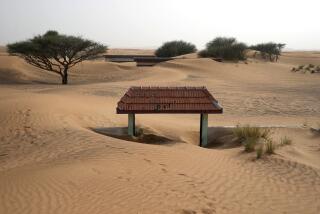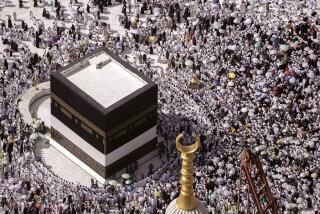Ancient Caravan City Undergoes a Thoroughly Modern Revival
- Share via
ALEPPO, Syria — It is one of the world’s last great souks, a caravan city on the old Silk Road that has captivated travelers since ancient times.
Its very name breathes the exoticism of the Orient, fragrant as the scent of perfume and spice that still wafts through its miles of covered bazaars.
The city in northwestern Syria near Turkey is reckoned to be 5,000 years old. Its people like to argue with residents of rival Damascus about almost everything--and they disagree especially on the question of which of the two communities is the oldest continually inhabited place on Earth.
The patriarch Abraham was said to have milked his cow here. Tamerlane conquered it. Shakespeare mentioned it. Venetian merchants established the first European trading outposts in it nearly 1,000 years ago. Lawrence of Arabia bedded here. So did Agatha Christie. And of course, the Orient Express rail line from Europe terminated at the city’s still-gracious Baghdad Station.
But today, old Aleppo--Halab in Arabic--is in need of a revival. Since the turn of the last century, the rich and middle classes have been exiting from the center in search of modern Western-style apartments and villas on the outskirts. The rural poor have been moving in to take their place.
And that means that the money is not there even to maintain, much less restore, the lovely courtyard houses shaded by Aleppo pines and the dozens of caravansaries--courtyard inns where caravans stopped for the night--now slowly crumbling into dilapidation.
But an ambitious Syrian-German project hopes to revitalize this treasure of world culture in one of the largest urban redevelopment plans ever aimed at an old city.
The $2-million-a-year effort seeks to address everything from sewer lines to traffic patterns to small-business development, says Jens Windelberg, a German professor of architecture who is team leader of the project largely funded by the German Development Corp., Germany’s foreign aid agency.
The underlying aim is to encourage the people of Aleppo to see the old center as key to the city’s economic and social health--and to preserve and value it.
Aleppo has never lost its character as a trading hub. A local proverb says, “An Aleppine can sell even a dried donkey’s skin.”
But instead of arriving on the camel trains that for centuries plied the Silk Road from China to Europe, today traders travel by plane and bus. They range from Russians eager to buy embroidery and ready-made clothes for sale back home, to Afghans and Tajiks selling hand-woven rugs and jewelry to finance the next leg of their hajj to Mecca. There’s even a small market for classic cars.
In an authoritarian, one-party state like Syria, it might be difficult to believe there is anything that resembles a grass-roots civic movement. But leading Syrian businesspeople, engineers, computer experts and clergy have flocked to join the German advisors to try to fix up the targeted area, a neighborhood of narrow, winding streets with 110,000 residents and 35,000 jobs, including those at the 15th and 16th century bazaars.
“We are trying to establish a program of reliable and sustainable redevelopment,” says Windelberg, who acknowledges that the project will take decades to complete.
Already, however, six years into the project, it is yielding some results. The government has named a directorate especially aimed at preserving the old city. A plan underway would restrict automobile traffic to a few key streets. And in the past three years, two upscale hotels have been built in abandoned European houses and nine “wonderful” restaurants have been opened, Windelberg says.
Merchants such as Fahwah Chalati say the increased municipal services in the area have helped make their bazaars cleaner and brighter, contributing to an uptick in shoppers and foreign tourism.
Chalati says he never intends to leave the old precinct. “I feel the history here,” he says. “I earn my living and I learn about history at the same time.”
More to Read
Sign up for Essential California
The most important California stories and recommendations in your inbox every morning.
You may occasionally receive promotional content from the Los Angeles Times.













